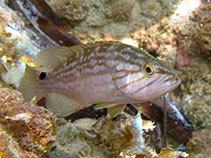| Family: |
Epinephelidae (Groupers) |
| Max. size: |
144 cm TL (male/unsexed); max.weight: 50 kg |
| Environment: |
demersal; marine; depth range 15 - 200 m |
| Distribution: |
Eastern Atlantic: Portugal to southern Angola; reports from islands require confirmation. Specimens from Madeira, Azores, Canary Islands, and Cape Verde have been examined by Heemstra (1991, Ref. 6512) and are identified to be Mycteroperca fusca. Replaced by Mycteroperca acutirostris in the western Atlantic. |
| Diagnosis: |
Dorsal spines (total): 11-11; Dorsal soft rays (total): 15-17; Anal spines: 3-3; Anal soft rays: 11-12. Distinguished by the following characteristics: usually reddish brown, sometimes mottled with black or pale grey spots with black streak above maxilla; juveniles with black saddle blotch on peduncle; oblong body, compressed, depth contained 2.8-3.2 times in SL; head length 2.5-2.7 in SL; convex interorbital area; enlarged serrae at angle of preopercle, forming rounded lobe set off by the indentation immediately above; nostrils subequal in juveniles, posterior nostrils about twice that of anterior ones in adults (Ref. 89707). |
| Biology: |
Occurs over rocky and sandy bottoms; young individuals very common in mangrove-lined lagoons. Feeds on mollusks (presumably cephalopods) and small fishes (Ref. 89707). Marketed fresh. |
| IUCN Red List Status: |
Least Concern (LC); Date assessed: 22 November 2016 Ref. (130435)
|
| Threat to humans: |
harmless |
Source and more info: www.fishbase.org. For personal, classroom, and other internal use only. Not for publication.
